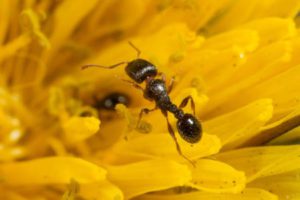SCHOOL CHILDREN COLLECT PAVEMENT ANTS FOR RESEARCH
By Chris Williams on January 24, 2020.
If you were a school kid, how much fun would it be to be asked to be part of a science project to collect ants? School children in various parts of the U.S. helped Florida researchers collect pavement ants for study.
Even more fun, the children got to use Pecan Sandies cookie crumbs for their ant bait (some probably went into other tummies!). The citizen science project, dubbed the “School of Ants” required that the children collect ants, place them in baggies and freeze them overnight, then ship them to a university research team led by Yuanmeng Zhang for study.
WHOSE LITTLE ANT ARE YOU?
The reason for the need for pavement ants from all over the United States was an attempt to trace the origin of the ants that apparently first arrived in the eastern U.S. 100 years ago in ships’ cargo. The researchers suspected that the species name for the pavement ant may not be correct and we could be dealing with a completely different ant.
Kids in most parts of the country, and especially here in the east, are already familiar with pavement ants (without knowing it) since these are the hill ants that trail along sidewalks and driveways, building dirt nest mounds and excavating little piles of sand through cracks. Although these ants are mostly outdoor nesters, piles of sand are one sign that you might have pavement ants nesting indoors.
PAVEMENT ANTS FORAGE INSIDE BUT USUALLY NEST OUTSIDE
But, in most cases, when pavement ants are found indoors, they are just foraging inside looking for food and are actually nesting outside under slabs, stones, bricks, patio blocks, boards, sidewalks, driveways, and in mulch. Most homes with pavement ant problems inside are built on concrete slabs or have basement walls made of cement block.
Pavement ants get into buildings through cracks in the slab, expansion joints, weep holes, around waste pipes and bath traps, through subslab heating ducts, and any other tiny openings. The ant workers will follow trails for as far as 30 feet to reach food sources. Like other ants, pavement ants feed on a variety of foods, but prefer foods with a high fat or grease content. Indoors, they like cheese, meats, insects, nuts, and pet food.
THANKS KIDS! PAVEMENT ANTS GET A NEW NAME!

Pavement ant on a yellow flower. Shutterstock.
Oh, the outcome of the research study? Pavement ants are no longer classified as Tetramorium caespitum. The molecular evidence from 90 samples from 26 states showed that the pavement ant did not qualify as a member of this species but instead came from a one-time introduction from Europe that could have occurred 200 years ago, and thus earned it the new name of Tetramorium immigrans. Doesn’t mean much to the average citizen or to the pavement ant, but it no doubt gets some taxonomists and entomologists excited!
Pavement ants are common in our region and are known for becoming active in late winter or very early spring. For more on pavement ants, check out these blogs: